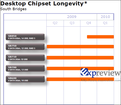- Joined
- Oct 9, 2007
- Messages
- 47,670 (7.43/day)
- Location
- Dublin, Ireland
| System Name | RBMK-1000 |
|---|---|
| Processor | AMD Ryzen 7 5700G |
| Motherboard | Gigabyte B550 AORUS Elite V2 |
| Cooling | DeepCool Gammax L240 V2 |
| Memory | 2x 16GB DDR4-3200 |
| Video Card(s) | Galax RTX 4070 Ti EX |
| Storage | Samsung 990 1TB |
| Display(s) | BenQ 1440p 60 Hz 27-inch |
| Case | Corsair Carbide 100R |
| Audio Device(s) | ASUS SupremeFX S1220A |
| Power Supply | Cooler Master MWE Gold 650W |
| Mouse | ASUS ROG Strix Impact |
| Keyboard | Gamdias Hermes E2 |
| Software | Windows 11 Pro |
As the market receives AMD's homegrown chipsets well since its successful 7-series, the company is preparing a new breed of platform core-logic technologies that will serve present and upcoming generations of the company's processors. From what we know so far, the company has designed the RD8xx and RS880, and has reportedly prepared prototype motherboards based on the chipsets. Several motherboard vendors have already prepared their upcoming SKUs based on the RS880 (AMD 880G), though all of these feature current SB710/SB750 series southbridge chips.
The successor, SB850, has been known to bring in an expanded feature set, and more importantly, an update with its storage controller. The southbridge will be one of the first ones to feature the third-generation SATA interface, that offers a maximum bandwidth of 6 Gbps between the system and the storage device, in comparison to 3 Gbps SATA II offers. In RAID mode, the controller will provide RAID 0, 1, JBOD, and RAID 5 modes. Six SATA channels will be supported in all. Other known features include support for 14 USB ports, albeit USB 2.0. AMD won't be embracing USB 3.0 just yet. The new southbridge will be released in Q4 2009 according to a portion of a roadmap slide by the company.

View at TechPowerUp Main Site
The successor, SB850, has been known to bring in an expanded feature set, and more importantly, an update with its storage controller. The southbridge will be one of the first ones to feature the third-generation SATA interface, that offers a maximum bandwidth of 6 Gbps between the system and the storage device, in comparison to 3 Gbps SATA II offers. In RAID mode, the controller will provide RAID 0, 1, JBOD, and RAID 5 modes. Six SATA channels will be supported in all. Other known features include support for 14 USB ports, albeit USB 2.0. AMD won't be embracing USB 3.0 just yet. The new southbridge will be released in Q4 2009 according to a portion of a roadmap slide by the company.

View at TechPowerUp Main Site




 Intel can keep their crap. Give me me 1394b&c and esata any day.
Intel can keep their crap. Give me me 1394b&c and esata any day.